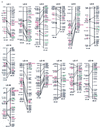Radiation hybrid mapping of the zebrafish genome
- PMID: 10449765
- PMCID: PMC22281
- DOI: 10.1073/pnas.96.17.9745
Radiation hybrid mapping of the zebrafish genome
Abstract
The zebrafish is an excellent genetic system for the study of vertebrate development and disease. In an effort to provide a rapid and robust tool for zebrafish gene mapping, a panel of radiation hybrids (RH) was produced by fusion of irradiated zebrafish AB9 cells with mouse B78 cells. The overall retention of zebrafish sequences in the 93 RH cell lines that constitute the LN54 panel is 22%. Characterization of the LN54 panel with 849 simple sequence length polymorphism markers, 84 cloned genes and 122 expressed sequence tags allowed the production of an RH map whose total size was 11,501 centiRays. From this value, we estimated the average breakpoint frequency of the LN54 RH panel to correspond to 1 centiRay = 148 kilobase. Placement of a group of 235 unbiased markers on the RH map suggests that the map generated for the LN54 panel, at present, covers 88% of the zebrafish genome. Comparison of marker positions in RH and meiotic maps indicated a 96% concordance. Mapping expressed sequence tags and cloned genes by using the LN54 panel should prove to be a valuable method for the identification of candidate genes for specific mutations in zebrafish.
Figures



Comment in
-
Zebrafish genetics: the enigma of arrival.Proc Natl Acad Sci U S A. 1999 Sep 14;96(19):10554-6. doi: 10.1073/pnas.96.19.10554. Proc Natl Acad Sci U S A. 1999. PMID: 10485858 Free PMC article. Review. No abstract available.
References
-
- Ringertz N R, Savage R E. Cell Hybrids. London: Academic; 1976.
-
- Ruddle F H. Nature (London) 1981;294:115–119. - PubMed
-
- Goss S, Harris H. Nature (London) 1975;255:680–684. - PubMed
-
- Cox D R, Burmeister M, Price E R, Kim S, Myers R M. Science. 1990;250:245–250. - PubMed
-
- Gyapay G, Schmitt K, Fizames C, Jones H, Vega-Czarnay N, Spillet D, Muselet D, Prud’homme J-F, Di C, Auffray C, et al. Hum Mol Genet. 1996;5:339–346. - PubMed
Publication types
MeSH terms
Substances
Grants and funding
LinkOut - more resources
Full Text Sources
Other Literature Sources
Molecular Biology Databases

